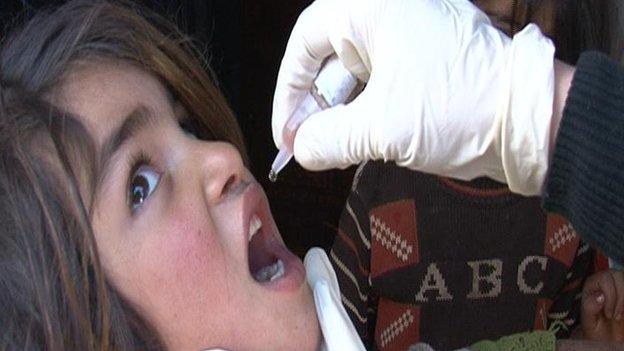Pakistan to immunise people going abroad against polio
- Published

Pakistan recorded 91 cases of Polio in 2013, according to the WHO
The Pakistani government says it will set up mandatory immunisation points at airports and border crossings to help stop its polio outbreak from spreading.
It comes after a World Health Organisation warning that polio has re-emerged as a public health emergency.
Pakistan has seen a rise in the disease, with immunisation campaigns often disrupted by Taliban militants.
The virus currently affects 10 countries worldwide, and is endemic in three countries, including Pakistan.
Polio mainly affects children under five years old.
Special measures
The virus is transmitted through contaminated food and water, and multiplies in the intestine. It can then invade the nervous system, causing paralysis in one in every 200 infections. It is capable of causing death within hours.
"Special measures will include establishing mandatory immunisation counters on all airports, border crossings and seaports for all travellers," Pakistani government spokesman Sajid Ali Shah said.
Officials say details of the campaign and how it would be implemented have yet to be worked out.
The BBC's Kim Ghattas in Islamabad says the Pakistani government gave no advance warning to the business community and seems to have done little to prepare for the logistics of administering the vaccine to travellers.
Pakistan, Cameroon and Syria were identified by the WHO as the countries posing the greatest risk of exporting the virus.
In its recommendation, the WHO said, external that all residents of Pakistan or long-term visitors should get a dose of the vaccine at least four weeks before international travel.
In case of urgent travel, it says, the vaccine should still be given just before departure.
But senior health official Saira Afzal Tarar told AFP that the health body's recommendations would make life harder for ordinary Pakistanis.
"By recommending travel restrictions on Pakistan, the WHO has strengthened those forces who actually banned polio drops," she said.
Attacks on vaccination campaigns in Pakistan by militants - who see them as a cover for spying - have allowed the virus to spread across its borders.
The WHO recorded 91 cases of polio last year, up from 58 in 2012.

Poliomyelitis has existed as long as human society, but became a major public health issue in late Victorian times with major epidemics in Europe and the United States. The disease, which causes spinal and respiratory paralysis, can kill and remains incurable but vaccines have assisted in its almost total eradication today.
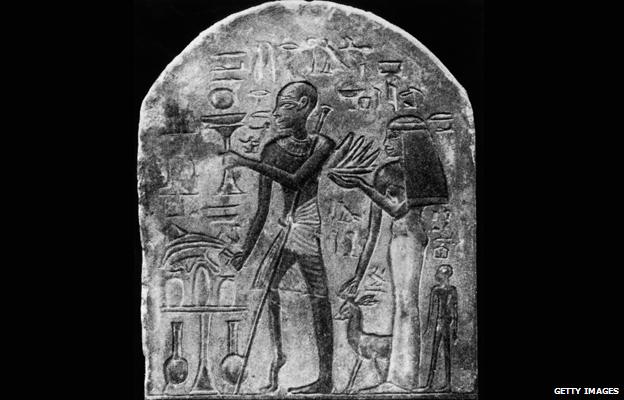
This Egyptian stele (an upright stone carving) dating from 1403-1365BC shows a priest with a walking stick and foot, deformities characteristic of polio. The disease was given its first clinical description in 1789 by the British physician Michael Underwood, and recognised as a condition by Jakob Heine in 1840. The first modern epidemics were fuelled by the growth of cities after the industrial revolution.

In 1916, New York experienced the first large epidemic, with more than 9,000 cases and 2,343 deaths. The 1916 toll nationwide was 27,000 cases and 6,000 deaths. Children were particularly affected; the image shows child patients suffering from eye paralysis. Major outbreaks became more frequent during the century: in 1952, the US saw a record 57,628 cases.
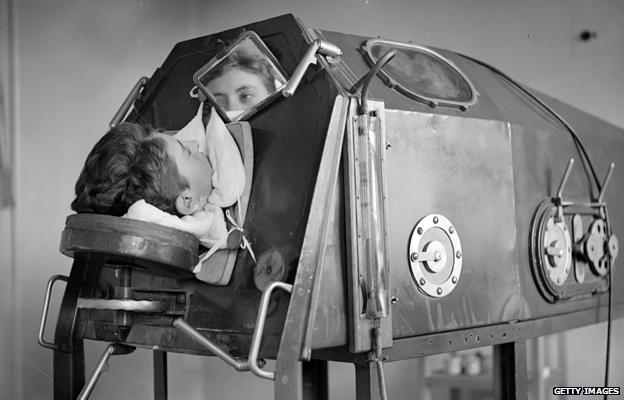
In 1928, Philip Drinker and Louie Shaw developed the "iron lung" to save the lives of those left paralysed by polio and unable to breathe. Most patients would spend around two weeks in the device, but those left permanently paralysed faced a lifetime of confinement. By 1939, around 1,000 were in use in the US. Today, the iron lung is all but gone, made redundant by vaccinations and modern mechanical ventilators.
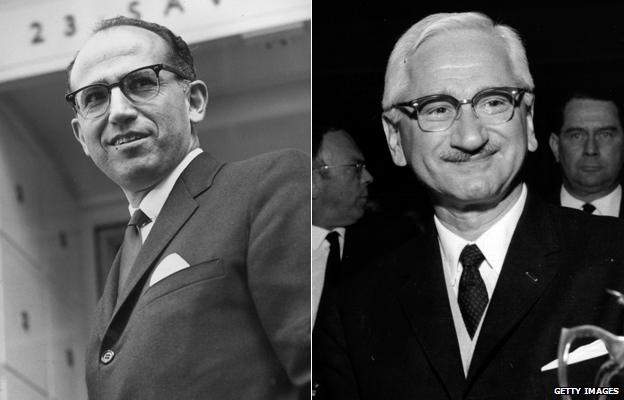
A major breakthrough came in 1952 when Dr Jonas Salk (L) began to develop the first effective vaccine against polio. Mass public vaccination programmes followed and had an immediate effect; in the US alone cases fell from 35,000 in 1953 to 5,300 in 1957. In 1961, Albert Sabin (R) pioneered the more easily administered oral polio vaccine (OPV).

Despite the availability of vaccines polio remained a threat, with 707 acute cases and 79 deaths in the UK as late as 1961. In 1962, Britain switched to Sabin's OPV vaccine, in line with most countries in the developed world. There have been no domestically acquired cases of the disease in the UK since 1982.
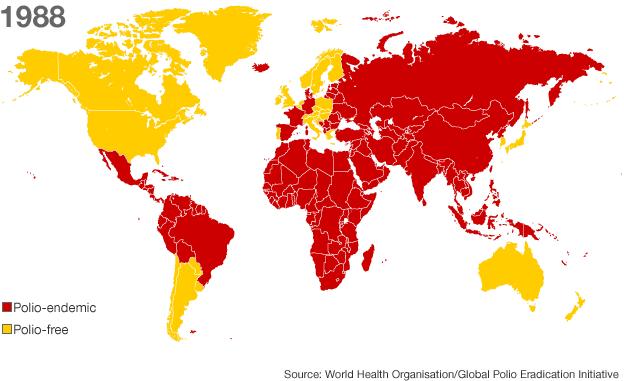
By 1988, polio had disappeared from the US, UK, Australia and much of Europe but remained prevalent in more than 125 countries. The same year, the World Health Assembly adopted a resolution to eradicate the disease completely by the year 2000.

The WHO Americas region was certified polio free in 1994, with the last wild case recorded in the Western Pacific region (which includes China) in 1997. A further landmark came in 2002, when the WHO certified the European region polio-free.
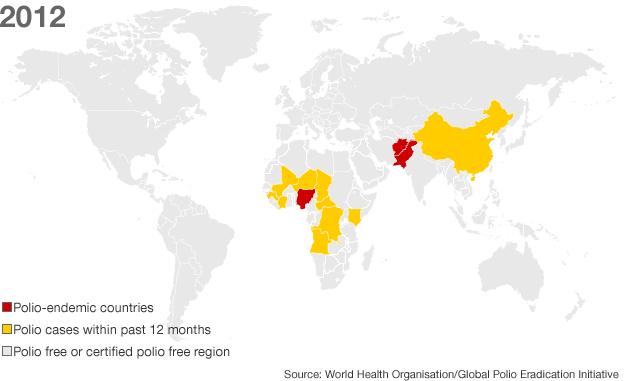
In 2012, Polio remains officially endemic in three countries - Afghanistan, Nigeria and Pakistan. Despite so much progress, polio remains a risk with virus from Pakistan re-infecting China in 2011, which had been polio free for more than a decade.
- Published5 May 2014
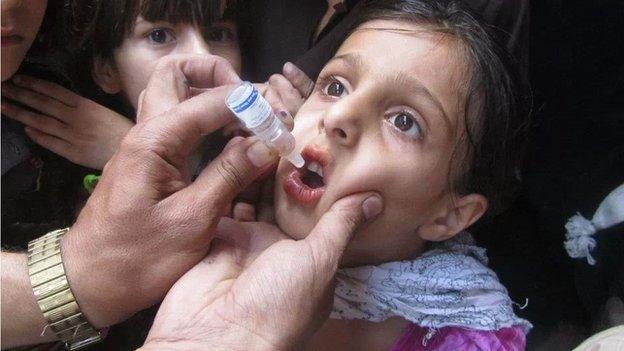
- Published19 December 2013
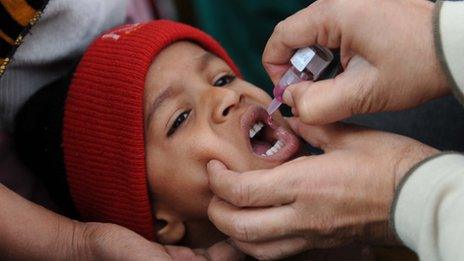
- Published26 March 2014

- Published25 September 2015
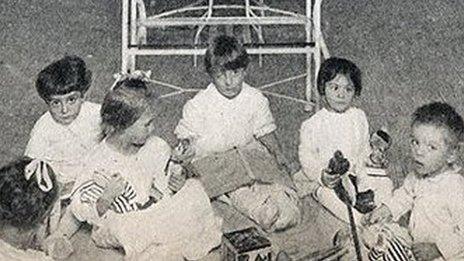
- Published27 March 2014

- Published19 December 2013
